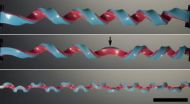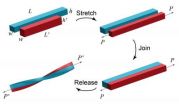(Press-News.org) Cambridge, Mass. – April 23, 2014 – While setting out to fabricate new springs to support a cephalopod-inspired imaging project, a group of Harvard researchers stumbled upon a surprising discovery: the hemihelix, a shape rarely seen in nature.
This made the researchers wonder: Were the three-dimensional structures they observed randomly occurring, or are there specific factors that control their formation? The scientists answered that question by performing experiments in which they stretched, joined, and then released rubber strips. Complemented by numerical simulations and analysis of the process, the results appear in a paper published in the journal PLOS ONE.
Knowing precisely how to make the structures, predictably and consistently, may enable scientists to mimic the geometrical features in new molecules that could lead to possible advances in modern nanodevices, including sensors, resonators, and electromagnetic wave absorbers.
"Once you are able to fabricate these complex shapes and control them, the next step will be to see if they have unusual properties; for example, to look at their effect on the propagation of light," says Katia Bertoldi, Associate Professor in Applied Mechanics at the Harvard School of Engineering and Applied Sciences (SEAS).
The shape that Bertoldi and colleagues at SEAS unexpectedly encountered is a hemihelix with multiple "perversions." Helices are three-dimensional structures; think of a corkscrew or a Slinky toy. Hemihelices form when the direction in which the spiral turns—known as the chirality—changes periodically along the length. The reversal in chirality is called a perversion.
The team was trying to make two-dimensional springs by taking two strips of rubber material of different lengths and stretching the shorter one to reach the same length as the longer one and then sticking them together, explains David R. Clarke, Extended Tarr Family Professor of Materials at SEAS. "We expected that these strips of material would just bend—maybe into a scroll. But what we discovered is that when we did that experiment we got a hemihelix and that it has a chirality that changes, constantly alternating from one side to another."
Jia Liu, a graduate student in Bertoldi's group, tested differences in the aspect ratio—the width-to-height ratio of the rubber strips—and discovered that when a strip is very wide relative to its height, it produces a helix. Further measurements revealed that there is a critical value of the aspect ratio at which the resulting shape transitions from a helix to a hemihelix with periodic reversals of chirality.
Other classes of materials would simply break when stretched to the mismatched strains that the polymers endured—likely the reason this behavior had never been observed before.
"We see deterministic growth from a two-dimensional state—two strips bonded together—to a three-dimensional state," Liu says. "The actual number of perversions, the diameter, everything else about it is entirely prescribed. There is no randomness; it's fully deterministic. So if you make one hundred of these, they'll always perform exactly the same way."
Bertoldi adds: "From a mechanical point of view you can look at these as different springs with very different behavior. Some of them are very soft and then they stiffen up. Some are more linear. Simply by changing geometry, you can design this whole family of springs with very different behavior with predictable results."
Bertoldi and Clarke believe that their findings provide important clues for how to fabricate a variety of three-dimensional shapes from flat parts.
"Intellectually, it's interesting—and we believe it is significant too," Clarke says. "There are a variety of complex shapes in nature that arise as a result of different growth rates. We stumbled quite by accident on a way to achieve fully deterministic manufacture of some three-dimensional objects."
INFORMATION:Other contributors to the paper were Jiangshui Huang, a postdoctoral research associate in Clarke's group and Tianxiang Su, a former postdoc in Bertoldi's group.
The work was supported in part by the Harvard Materials Research Science and Engineering Center, which is supported by the National Science Foundation (DMR-0820484).
Scientists discover a new shape using rubber bands
Form not found in nature could spur creation of new molecules
2014-04-24
ELSE PRESS RELEASES FROM THIS DATE:
Microbes provide insights into evolution of human language
2014-04-24
Big brains do not explain why only humans use sophisticated language, according to researchers who have discovered that even a species of pond life communicates by similar methods.
Dr Thom Scott-Phillips of Durham University led research into Pseudomonas aeruginosa, a type of bacteria common in water and soil, which showed that they communicated in a way that was previously thought to be unique to humans and perhaps some other primates.
The bacteria used combinatorial communication, in which two signals are used together to achieve an effect that is different to the ...
People with mild cognitive impairment may die at higher rate than people without condition
2014-04-23
ROCHESTER, Minn. — Mayo Clinic research studying the relationship between death and the two types of mild cognitive impairment (MCI) suggests that people who have these conditions die at a higher rate than people without MCI. The research was released today and will be presented at the American Academy of Neurology's 66th Annual Meeting in Philadelphia, April 26 to May 3, 2014.
For the study, 862 people with thinking problems and 1,292 with no thinking problems between the ages of 70 and 89 were followed for nearly six years. Over the course of the study, 331 of the ...
People with more education may recover better from traumatic brain injury
2014-04-23
MINNEAPOLIS – People with more years of education may be better able to recover from a traumatic brain injury, according to a study published in the April 23, 2014, online issue of Neurology®, the medical journal of the American Academy of Neurology.
The study examined people with moderate to severe traumatic brain injuries, most of which were from motor vehicle accidents or falls. All were taken to the emergency department and spent time in the hospital after the injury and also for inpatient rehabilitation.
"After these types of injuries, some people are disabled ...
Study examines risk of early death for people with mild cognitive impairment
2014-04-23
PHILADELPHIA – One of the first studies to look at a relationship between death and the two types of mild cognitive impairment (MCI), or problems with memory and thinking abilities, suggests that people who have thinking problems but their memory is still intact might have a higher death rate in a period of six years compared to those who have no thinking or memory problems. The research was released today and will be presented at the American Academy of Neurology's 66th Annual Meeting in Philadelphia, April 26 to May 3, 2014. The same was suggested in the study for those ...
Marijuana use may increase heart complications in young, middle-aged adults
2014-04-23
Marijuana use may result in cardiovascular-related complications — even death — among young and middle-aged adults, according to a French study reported in the Journal of the American Heart Association.
"In prior research, we identified several remarkable cases of cardiovascular complications as the reasons for hospital admission of young marijuana users," said Émilie Jouanjus, Pharm.D., Ph.D., lead author of the study and a medical faculty member at the Centre Hospitalier Universitaire de Toulouse in Toulouse, France. "This unexpected finding deserved to be further analyzed, ...
Higher education associated with better recovery from traumatic brain injury
2014-04-23
Better-educated people appear to be significantly more likely to recover from a moderate to severe traumatic brain injury (TBI), suggesting that a brain's "cognitive reserve" may play a role in helping people get back to their previous lives, new Johns Hopkins research shows.
The researchers, reporting in the journal Neurology, found that those with the equivalent of at least a college education are seven times more likely than those who didn't finish high school to be disability-free one year after a TBI serious enough to warrant inpatient time in a hospital and rehabilitation ...
Rural microbes could boost city dwellers' health
2014-04-23
The greater prevalence of asthma, allergies and other chronic inflammatory disorders among people of lower socioeconomic status might be due in part to their reduced exposure to the microbes that thrive in rural environments, according to a new scientific paper.
The article, published in the journal Clinical & Experimental Immunology, argues that people living in urban centers who have less access to green spaces may be more apt to have chronic inflammation, a condition caused by immune system dysfunction.
When our immune systems are working properly, they trigger inflammation ...
Princeton release: Not just the poor live hand-to-mouth
2014-04-23
When the economy hits the skids, government stimulus checks to the poor sometimes follow.
Stimulus programs — such as those in 2001, 2008 and 2009 — are designed to boost the economy quickly by getting cash into the hands of people likely to turn around and spend it.
But sending cash to just the very poor may not be the right approach, according to researchers from Princeton University and New York University who analyzed information on the finances of U.S. households from 1989 to 2010.
"What we found is that households that have the lowest liquid wealth — where ...
NASA satellites show drought may take toll on Congo rainforest
2014-04-23
A new analysis of NASA satellite data shows Africa's Congo rainforest, the second-largest tropical rainforest in the world, has undergone a large-scale decline in greenness over the past decade.
The study, led by Liming Zhou of University at Albany, State University of New York, shows between 2000 and 2012 the decline affected an increasing amount of forest area and intensified. The research, published Wednesday in Nature, is one of the most comprehensive observational studies to explore the effects of long-term drought on the Congo rainforest using several independent ...
WSU innovation improves drowsy driver detection
2014-04-23
SPOKANE, Wash.—Researchers at Washington State University Spokane have developed a new way to detect when drivers are about to nod off behind the wheel.
Their recently patented technology is based on steering wheel movements—which are more variable in drowsy drivers—and offers an affordable and more reliable alternative to currently available video-based driver drowsiness detection systems.
Van Dongen"Video-based systems that use cameras to detect when a car is drifting out of its lane are cumbersome and expensive," said Hans Van Dongen, research professor at the WSU ...
LAST 30 PRESS RELEASES:
Philippines' counter-terrorism strategy still stalled after 7 years since the ‘ISIS siege’ on Marawi
BU doc honored by the American College of Surgeons
Airborne single-photon lidar system achieves high-resolution 3D imaging
Stem cell transplants and survival rates on the rise across all racial and ethnic groups
Study reports chlamydia and gonorrhea more likely to be treated per CDC guidelines in males, younger patients and individuals identifying as Black or multiracial
Plastic food packaging contains harmful substances
Spring snow, sparkling in the sun, can reveal more than just good skiing conditions
Using AI to improve diagnosis of rare genetic disorders
Study unveils balance of AI and preserving humanity in health care
Capturing and visualizing the phase transition mediated thermal stress of thermal barrier coating materials via a cross-scale integrated computational approach
Study reveals emotional turmoil experienced after dog-theft is like that of a caregiver losing a child
PhRMA Foundation awards $1M for equity-focused research on digital health tools
Women with heart disease are less likely to receive life-saving drugs than men
How electric vehicle drivers can escape range anxiety
How do birds flock? Researchers do the math to reveal previously unknown aerodynamic phenomenon
Experts call for global genetic warning system to combat the next pandemic and antimicrobial resistance
Genetic variations may predispose people to Parkinson’s disease following long-term pesticide exposure, study finds
Deer are expanding north, and that’s not good for caribou
Puzzling link between depression and cardiovascular disease explained at last: they partly develop from the same gene module
Synthetic droplets cause a stir in the primordial soup
Future parents more likely to get RSV vaccine when pregnant if aware that RSV can be a serious illness in infants
Microbiota enterotoxigenic Bacteroides fragilis-secreted BFT-1 promotes breast cancer cell stemness and chemoresistance through its functional receptor NOD1
The Lundquist Institute receives $2.6 million grant from U.S. Army Medical Research Acquisition Activity to develop wearable biosensors
Understanding the cellular mechanisms of obesity-induced inflammation and metabolic dysfunction
Study highlights increased risk of second cancers among breast cancer survivors
International DNA Day launch for Hong Kong’s Moonshot for Biology
New scientific resources map food components to improve human and environmental health
Mass General Brigham research identifies pitfalls and opportunities for generative artificial intelligence in patient messaging systems
Opioids during pregnancy not linked to substantially increased risk of psychiatric disorders in children
Universities and schools urged to ban alcohol industry-backed health advice
[Press-News.org] Scientists discover a new shape using rubber bandsForm not found in nature could spur creation of new molecules




